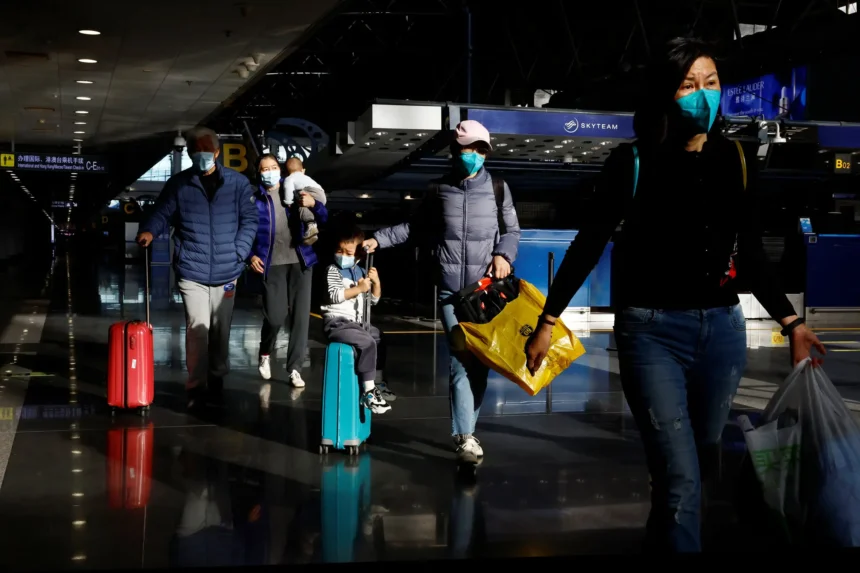Days before China removes border controls and ushers in an eagerly anticipated return to travel for a population that has been largely stuck at home for three years, more countries around the world are requiring visitors from China to take Covid tests.
The latest step in China’s dismantling of its “zero-Covid” regime, which began last month in response to historic protests against a suffocating series of mass lockdowns, will end on Sunday.
However, the sudden shifts have brought the virus to a significant portion of China’s 1.4 billion people for the first time, triggering an infection wave that has overwhelmed some hospitals, depleted pharmacy shelves, and sparked international concern.
The World Health Organization stated on Thursday that China’s official virus data was under-reporting the true extent of its outbreak. On Thursday, Greece, Germany, and Sweden joined more than a dozen other nations in demanding Covid tests from Chinese travelers.
A defiant tone has been taken by Chinese officials and state media, who have defended the way the outbreak was handled, downplayed the severity of the surge, and criticized the requirement that residents travel to foreign countries.
In an editorial published late on Thursday, the Global Times, a publication of the official People’s Daily of the ruling Communist Party, stated, “Some Western media and some Western politicians will never be satisfied no matter how China decides to deal with the Covid-19 epidemic.”
The decisions to impose testing on travelers from China have also been criticized by the global aviation industry, which has been battered by years of pandemic restrictions. After January 8, inbound travelers in China will still be required to undergo pre-departure testing.
The reopening has been criticized as being too hasty by some Chinese citizens.
A 70-year-old man who went by the surname Zhao told Reuters in Shanghai, “They should have taken a series of actions before opening up… and at the very least ensured that the pharmacies were well stocked.”
Thursday’s five new mainland Covid deaths brought China’s official virus death toll to 5,264, one of the lowest in the world.
However, this is in contrast to the actual situation, where hospitals are overflowing with elderly patients wearing respirators and funeral parlors are overwhelmed.
According to the Shanghai Morning Post, more than 200 taxi drivers are driving ambulances in Shanghai to meet the demand for emergency services.
Experts in international health believe that Beijing’s narrow definition of Covid deaths does not accurately reflect the true number, which could exceed one million this year.
Investors are hopeful that China’s reopening will eventually reenergize the $17 trillion economy, which has experienced the slowest growth in nearly 50 years.
China’s yuan rose on Friday as a result of these hopes and policy measures to assist in revitalizing its troubled property sector.
In the meantime, the Shanghai Composite Index and China’s blue-chip CSI300 Index have gained more than 2% in the first trading week of the year.
In a note, HSBC’s head of equity strategy, Asia Pacific, Herald van der Linde stated, “While the re-opening is likely to be a bumpy affair amid surging COVID-19 cases and increasingly stretched health systems, our economists expect growth momentum across Asia to gather steam, led by China.”
Southeast Asia open
The mainland is also set to open the border with its special administrative region of Hong Kong on Sunday, for the first time in three years, as the major Lunar New Year holidays end this month.
On the same day, ferry services between the city and Macau, the gambling capital, will resume.
Hong Kong’s Cathay Pacific Aviation routes said on Thursday it would beyond twofold trips to central area China. The number of flights to and from China has not increased significantly since COVID.
The World Health Organization (WHO) has issued a warning that the holiday, which begins on January 21 and typically sees the largest human migration on the planet as people return home to visit families in small towns and villages, could trigger another infection wave if vaccination rates are not increased and other precautions are not taken.
Over the holiday, authorities anticipate 2.1 billion passenger trips—by road, rail, water, and air—double last year’s 1.05 billion journeys.
To reduce the infection risk for elderly relatives, pregnant women, and infants, the transportation ministry has urged people to exercise caution.
Southeast Asia, where countries have not required Chinese visitors to take Covid tests, is one potential beneficiary of China’s opening.
The 11 countries in the region will treat Chinese travelers similarly to other travelers, with the exception of Malaysia and Thailand’s testing of airline wastewater for the virus.
According to a recent survey conducted by the trade show ITB China, as many as 76 percent of Chinese travel agencies ranked Southeast Asia as the most popular destination when outbound travel resumed.
Many Chinese people have announced their travel plans on social media, but some remain cautious.
One WeChat user from Tianjin warned, “You want to see the world, but the world might not want to see you.”







